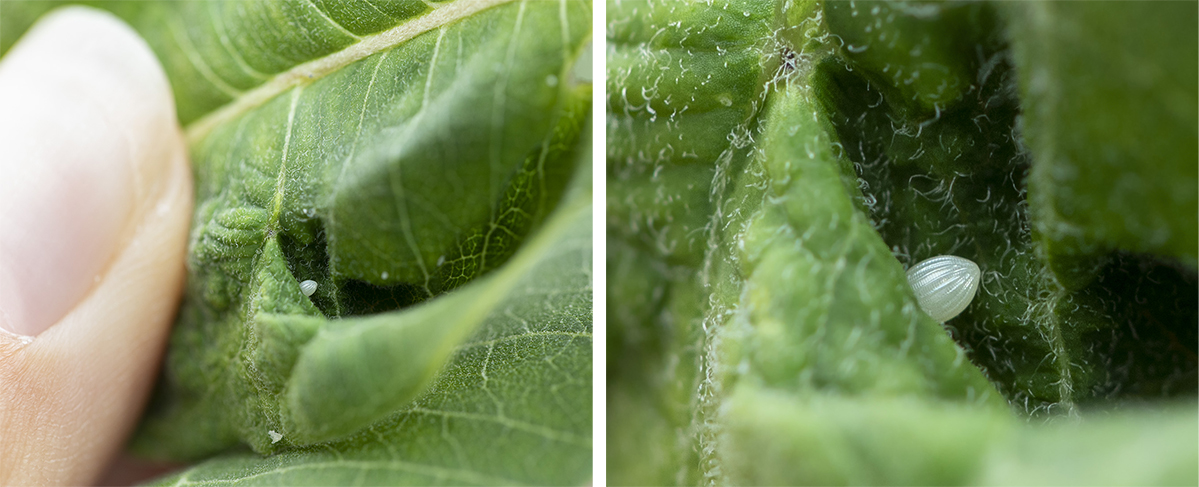LEAH CONWAY
Seasonal Naturalist – Blacklick Woods

The monarch butterfly may be the most famous of invertebrates here in the US — followed closely by the black widow spider and honeybee. Like other pollinators, monarchs perform a vital role in our ecosystems, both facilitating the reproduction of countless flowering plants and serving as a food source for certain predators. Few will dare to consume larval or adult monarchs, but some spiders, ants, and even select birds can tolerate their foul taste and toxicity.
Adult female monarchs land briefly and deposit a single white egg per visit to each leaf or plant. Common milkweed and swamp milkweed are reliable favorites, but they may lay eggs on any member of the milkweed genus.
The caterpillars, after hatching from an egg measuring just 0.9mm wide and 1.2mm tall, immediately begin consuming their host plant. For 10-18 days, the caterpillar will eat as much milkweed as it can get its jaws on, sporting black, white and bright yellow stripes to remind predators that consumption guarantees an unpleasant experience. Five in-star stages later, it is 3,000 times its size upon hatching, and it begins pupation.

Pupation is a fascinating process. During the chrysalis stage, the caterpillar’s body hardens and reforms. Enzymes break down much of the caterpillar’s tissues, but some groups of cells — known as “imaginal discs” — resist deconstruction and remain highly organized, eventually forming the eyes, legs, wings and other adult butterfly body parts. These imaginal discs develop even before a caterpillar hatches from its egg, but usually remain dormant until pupation. In certain species, some of the caterpillar’s original organs can also survive the enzyme digestion, which may explain why studies have found that if a caterpillar is trained to dislike a specific scent, it will, as an adult butterfly, continue to dislike it!
The chrysalis itself is actually the caterpillar’s skin or exoskeleton — one distinction that separates butterflies from moths.

The transformation from pupa to butterfly lasts roughly 10 days — more if the climate is cooler and less if warmer. When it’s ready to emerge, the fully formed adult butterfly will break free from the chrysalis exoskeleton and spend several hours drying and stretching its wings. To accomplish this, it will flap its wings over and over while perched, pushing a substance called hemolymph, which functions much like our blood, through the veins in its wings.

In Ohio, if it takes wing in spring or early/mid summer, it will join the general population to nectar on flowering plants and reproduce for a period spanning about two to six weeks. But if it begins flight in late summer, it will begin migrating to its overwintering grounds in Mexico, some 2,500 miles away! There, it will roost in the millions with others of its kind until spring, when it will return to its summering grounds to mate, making it one of the longest-lived butterflies in the world.

While the US Fish and Wildlife Service hasn’t designated monarchs — either our eastern or the western population — as endangered, the International Union for the Conservation of Nature (IUCN) has added them to their Red List, denoting them as “vulnerable.”
To help monarch and other pollinator populations, you can plant native milkweeds in your garden, but avoid using pesticides, and provide a food source for migrating monarchs in autumn by planting late-blooming nectar plants like ironweed and goldenrod.


Is that like wild grape.vine?
Hi Mary, that last photo in the article is definitely a plant in the grapevine family, which seemed very attractive to the monarch butterflies that day.
I have 6 monarch caterpillars on milkweed – they are pretty big I am concerned that they are too late in the season to make it adulthood. Anyone know if they are still safe it is September 2, 2024. I live in community along Lake Erie.
Hi Valerie, as you say, it is late in the season. They will be in the chrysalis stage (once they get there) for about eight to 15 days. Assuming they are ready for that stage soon, they should be okay to make their trip to Mexico.